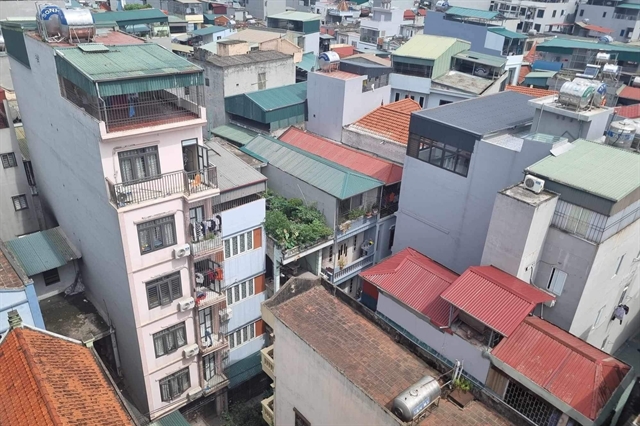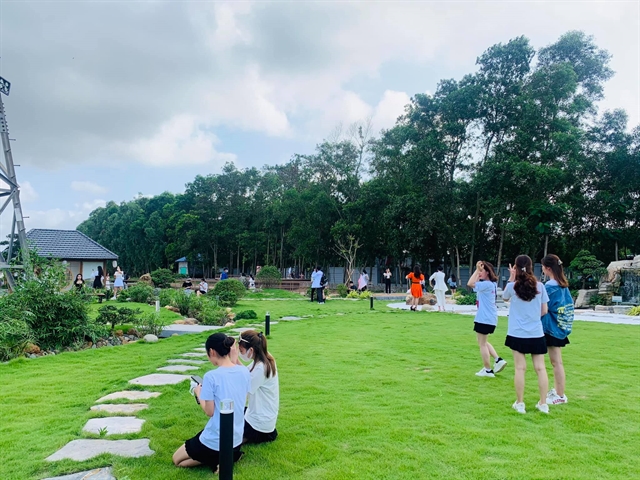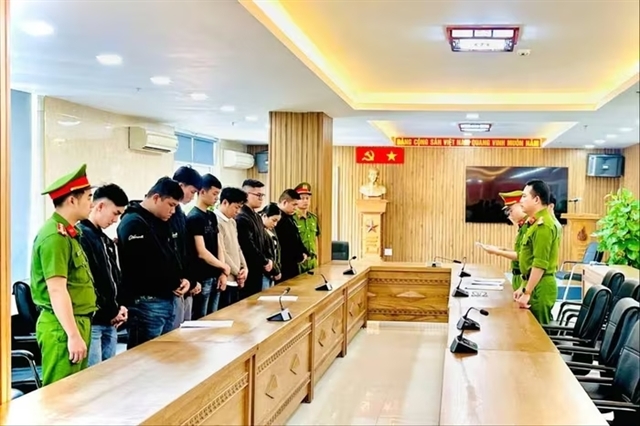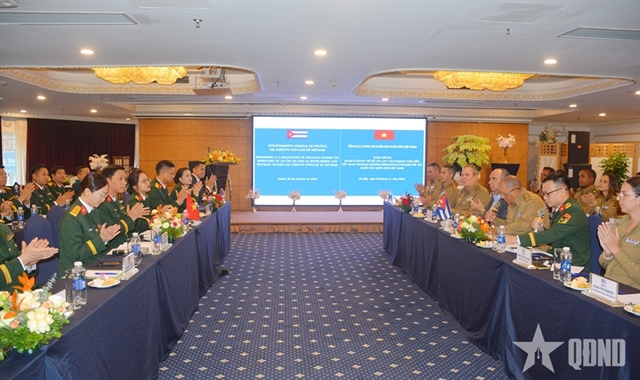 Business Beat
Business Beat


|
| The ‘Kyousei-no-niwa” Garden at the Nam Cầu Kiền Industrial Park in Hải Phòng City. |
Compiled by Thiên Lý
The ‘Kyousei-no-niwa” Garden opened on December 1 last year at the Nam Cầu Kiền Industrial Park in Hải Phòng City.
The Japanese garden covers an area of 30,000 sq.m, using water directly treated from a wastewater treatment plant in the park.
The park, built by the Shinec Joint Stock Company and Japan’s Kitakyushu City, has all the typical features of an eco-park.
Its production chains are circular from input to output through reuse, refurbishment and recycling of solid wastes and wastewater.
Experts said it meets the basic requirements of a circular economy, which keeps products and materials in use for as long as possible to get the maximum value from them.
Its chairman, Phạm Hồng Diệp, said the circular economy model is aimed at creating a symbiotic association between the economy, environment and society to achieve the final goal of increase in sustainable natural resources flows.
In October the Institute of Environmental Health and Sustainable Development belonging to the Vietnam Union of Science and Technology Association organised a workshop to review the model of the Nam Cầu Kiền Eco-Park.
At the event, scientists and other experts said at a time when the country has few circular economy business models, the Nam Cầu Kiền Industrial Park should be a template for widespread development.
VUSTA chairman Phan Xuân Dũng said practical studies at the park showed that adopting the model at other industrial parks in the country is feasible and likely to be successful.
Eco-parks
Việt Nam is seeing a strong increase in industrial production and the number of industrial zones (IZs), but the inefficient use of resources and lack of green technologies have a negative impact on the environment and people’s lives, and increase costs for businesses.
Developers are realising that only development of eco- production models will help address all these problems.
The models have already shown they bring benefits like saving costs, reducing resource consumption and the discharge of solid waste and wastewater into the environment and improving workers’ health and people’s quality of life.
Some eco-industrial parks have been trialled successfully under a project funded by the Global Environment Facility and Switzerland, helping save hundreds of billions of đồng annually.
They include Khánh Phú and Gián Khẩu IZs in the northern province of Ninh Bình, the Hòa Khánh IZ in Đà Nẵng City and the Trà Nóc IZ in Cần Thơ City.
Statistics show that these parks cost VNĐ270 billion (US$11.74 million) to develop, but within three years helped save VNĐ171 billion by reducing the use of raw materials, power, water, fuel, and chemicals.
Besides, solid waste discharge was reduced by more than 9,300 tonnes and wastewater by 850,000cu.m.
Acknowledging these benefits, more and more industrial parks in the country are embracing the eco-park model to promote sustainable growth and attract FDI.
The Government is also supporting this trend, and issued a decree in 2018 setting out criteria for eco-industrial parks.
Analysts consider eco-industrial parks one of the main models of the circular economy.
Promoting the circular economy requires active innovation, investment in modern technologies, limiting energy consumption, and making products capable of being recycled.
By late 2020 Việt Nam had 381 industrial parks and export processing zones with a combined area of 114,000ha, which have made a very important contribution to the country’s economic growth.
But they also generated a tremendous amount of industrial waste, and with only 31 per cent being treated, they caused severe pollution, greatly wasted natural resources and thus significantly increased businesses’costs.
In HCM City alone, industrial parks and export processing zones are estimated to discharge 70,000 tonnes of solid waste annually, and the figure might be 10 times higher if discharge by production establishments outside the zones are also taken into account.
The General Department of Environment said 55 million tonnes of solid wastes are generated annually in the country from industrial production activities, and a very low portionis treated before discharge.
Plastic wastes are often cited as an example.
According to a new study by the World Bank Group, 75 per cent of the value of recyclable plastics, equivalent to $2.2-2.9 billion a year, is lost in Việt Nam because used plastics are not sorted, collected or recovered.
Though Việt Nam has many small recyclers and an average recycling rate of 33 per cent for the four key resins researched, the rate of plastics recycled is quite small.
Carolyn Turk, the World Bank country director for Việt Nam, and Kyle Kelhofer, the IFC country manager for Việt Nam, Cambodia and Lao PDR, told Việt Nam News that solid waste volumes have doubled in less than 15 last years and are expected to double again by 2030.
Therefore, 3R (reduce, reuse, and recycle) interventions must be supported by nation-wide investment in solid waste management (SWM) infrastructure for better waste sorting, collection and transport, with co-ordination between national and provincial governments needed to drive SWM efficiencies, Kelhofersaid.
Analysts also said that Việt Nam is increasingly grappling with industrial wastes, while raw materials and fossil fuels are quickly depleting.
Most Vietnamese businesses use outdated technologies, operate on a small scale and lack resources to invest in recycling.
The country seeks to transition to a low-carbon growth strategy, and aims for green recovery in future.
Thus, it is now the right time for mainstreaming a circular economy for plastics usage to manage resources, design out wastes and emissions and restore the environment.
Thi way, Vietnamese enterprises would be able to achieve their goals of sustainable consumption and production.
How to do it?
Vietnamese businesses are told that they cannot ignore the circular economy, especially with the country’s global integration and the strong commitments it has made on environmental safety standards under various free trade agreements.
The circular economy is also expected to help the businesses significantly add value.
But analysts said the switch to the model would require market and structural changes and significant investments to address infrastructure gaps.
Nguyễn Quang Vinh, vice chairman of the Việt Nam Business Council for Sustainable Development, said the circular economy is a new model but has proven very effective and suitable for all kinds of economies.
Awareness of environmental protection should go hand in hand with practical actions to protect the environment amid the rapid growth in economic activities, he said.
But since it is a new concept for many Vietnamese businesses, especially small and medium-sized enterprises, it puts them at risk because of the scarcity of resources and fluctuations in their prices, he added.
Analysts said the number of enterprises in the country interested in the circular economy model has increased in the last three years, though admittedly it is still only popular with large ones, especially foreign-owned.
For instance, Unilever has an efficient programme to collect and recycle plastic packaging and sortwaste at source, and Coca Cola has a programme to collect and classify plastic bottles.
The two companies are core members of the ‘Zero Waste to Nature’ initiative.
Analysts said the circular economy would be the key to the success and sustainable development of enterprises in the country regardless of size or model.
Minister of Natural Resources and Environment Trần Hồng Hà told a recent webinar that Việt Nam is working to shift from a linear to a circular economy based on the three pillars of designing and prolonging material lifespan, reducing waste and emissions and restoring the ecology.
He said his ministry is working with other agencies to create criteria, roadmaps and mechanisms to encourage the development of the circular economy, especially at industrial parks.
The environment ministry, in collaboration with the Ministry of Finance, is also reconsidering policy tools related to natural resources and the environment, he added.
Vinh said it is important to have detailed guidelines for enterprises, especially in industrial parks, on the circular economy business model.
Experts from the Institute of Natural Resources and Environmental Policy and Strategy said the circular economy should go hand in hand with technological innovation and design.
To develop the circular economy, priority should be given to creating a clear legal framework and carrying out extensive research, they said.
“It is necessary to implement circular economy development with a roadmap and priorities, learn from international experience, and use high technology. And the first requirement is sorting of waste at source.” VNS




